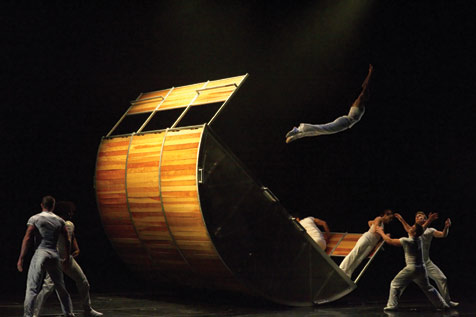Jacques Heim Brings L.A.-Based Diavolo to Santa Barbara
Acrobatics Meets Architecture

When it comes to contemporary dance choreographers, Jacques Heim is an anomaly; he’s not a dancer. The French-born, British-educated Heim is the artistic director of Los Angeles-based acrobatic dance company Diavolo, though he’s best known for choreographing the Cirque du Soleil show K , in 2005. In his own company, Heim employs not just dancers, but gymnasts, actors, rock climbers, and martial artists. Rather than hiring traditional set designers, he works with engineers to create the dynamic architectural structures that characterize his work. I caught up with Heim over the phone last week in advance of Diavolo’s appearance at the Granada on Saturday, May 10.
Tell me a little bit about your unusual blend of dance and architecture. How did it evolve? I never consider myself a traditional choreographer because I’m not a dancer. I’m pretty much the most dyslexic and inflexible choreographer you’ll ever meet. In another life I’d be an architect, but I don’t have the discipline to be behind a desk, so I mix architecture and choreography together. My main influences are architects like Santiago Calatrava, Louis Kahn, Le Corbusier, and Leonardo da Vinci, who is for me an architect/scientist/geometrician. I never use traditional set designers-they don’t understand my language. I always use architects, engineers, or sculptors to design my structures.

How do the concepts for these structures originate? For example, we were doing a show in Aspen, Colorado, and our dressing room was in an elementary school classroom, and I found a box of colored, wooden blocks. My dancers were rehearsing, and they said, “Do you want to come watch the tech?” and I said, “No, I want to sit here and play with these blocks.” The shape I found most interesting was not a cube but a tetrahedron, with four sides. After an hour and a half of playing with them, I realized that three blocks created a cube. I decided this would be a very interesting structure for a dance, so I stole those blocks and told the presenter if I did a piece with it I’d buy the children more blocks. That was the departure for what became “Foreign Bodies.”
You talk about wanting to make dance more mainstream, but you’re also interested in pushing the boundaries of dance. How do those two goals work together? I think pushing the boundaries of dance is trying to make it mainstream. When I decided I wanted to have a company here, I was like, “Okay, what’s already out there?” I love this country, I want to be in America, and so I had to research how people look at dance. What I realized was that there were already lots of modern dance companies that were doing great. This country didn’t need another one. We needed a company that was different, that was organic, that people could connect to. If I decided to do abstract, weird, modern movement, I’d alienate my audience. I decided to mix a tiny bit of ballet and modern dance with acrobatics and pedestrian movement, so the result would not be so foreign, yet there is a “wow” factor because of the structures.
What inspires you most? Creation; creating something from scratch. Collaborating with my dancers and designers. Coming together in the studio to accomplish a piece. There’s something priceless in that. I know that Diavolo is a very, very difficult company to be in. To be a member you have to be pretty crazy because you have to be unafraid of heights, blood, and heavy contact. You have to have technique, gymnastic ability, and the strength to lift your own weight. You have to know your body in the air. You have to know how to build the structures, break them apart, and load them in the truck. You have to speak well in front of a crowd, to describe the work, to create, to come up with ideas. You have to collaborate, so there is no ego, and there are no divas. I ask for a two-year minimum commitment from my dancers, because after a few years you come out so much more confident and stronger as a dancer that you can audition for other companies you never thought you could audition with before. In a way, Diavolo is like a mini-training program. Seeing my dancers grow throughout the years is great.
It sounds like you care a lot about your dancers. Absolutely. For this work, completely. We operate like a family, a community. Trust and teamwork are our two principal themes. If I cannot care about someone, or someone has an ego, that person is gone. There is no room for that. It’s too hard. You don’t get paid that well.
4•1•1
Diavolo will perform at the Granada Theatre on Saturday, May 10, at 8 p.m. For tickets, call 899-2222 or visit granadasb.org. For more on Diavolo, visit diavolo.org.



